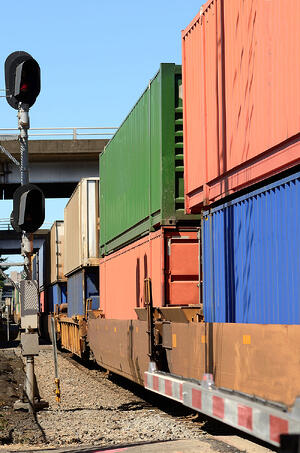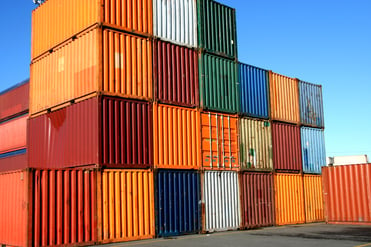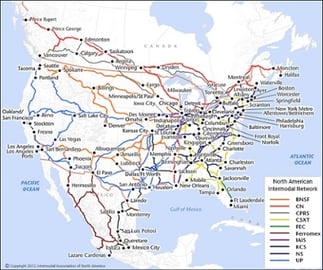
JB Hunt's Intermodal Model vs Class I Railroads: Pros and Cons of Each
November 26, 2019 •Rick LaGore

InTek Freight & Logistics Capacity Solutions Division made the decision over a decade ago that it wanted to be the place where shippers could come to get the best service and capacity for intermodal possible. The result of putting that stake in the ground meant that we were deciding to compete directly with the largest and best funded intermodal transportation providers, JB Hunt Intermodal, answer questions on price, service, capacity, etc.
Over the years our respect has only increased for JB Hunt and a few week’s back I provided a very positive review on JBH in the FreightWaves article entitled “Railroads Face Major Challenges to Jump-Start their Intermodal Business.”
J.B. Hunt offers what LaGore said is a compelling value proposition for big shippers, particularly in a market with relatively loose capacity. JBH pitches what is tantamount to a dedicated service in which it will take care of all of a customer’s intermodal requirements. Hunt also backs up its pledge with unmatched directional flexibility in its intermodal network, LaGore explained. In return, customers can’t cherry-pick lanes, meaning they must be all in with Hunt, according to LaGore. "Hunt is the 1,600-pound gorilla in the room," said LaGore. "They are very good at what they do …”
To compete in the intermodal space with JB Hunt, InTek engaged in the intermodal freight market by writing countless articles, speaking on numerous industry panels and webinars, contributing content to industry magazines, consulting with industry analysts and collecting and publishing pricing data for the market.
We do all of this to help educate ourselves and shippers with the tools necessary to be successful with executing an intermodal transportation strategy into their logistics and supply chains.
Because of the experience and expertise our leadership team has gathered in working with shippers Class I Railroad, JB Hunt or other bi-modal intermodal service providers, we feel we are uniquely positioned to write an in-depth pros and cons article on intermodal transportation.
Bi-Modal versus Non-Asset Intermodal Transportation Model
 Before jumping into the article, we need to have a quick discussion on the two IMC models employed in the intermodal space: bi-modal and non-asset. The importance and nuances of the two different models is what drives the pros and cons of intermodal service.
Before jumping into the article, we need to have a quick discussion on the two IMC models employed in the intermodal space: bi-modal and non-asset. The importance and nuances of the two different models is what drives the pros and cons of intermodal service.
Bi-modal is what is often thought to be the asset model. The top-of-mind bi-modal intermodal provider is JB Hunt. They are the single largest owners of 53’ private intermodal containers in North America. The majority of their service also operates through their company dray driver and equipment. JBH does not own any rail equipment, but they do have very close relationships with the BNSF, Norfolk Southern, CSX, CN, CPKC.
The non-asset model is a bit of a misnomer in that it is the model employed through the IMCs that the Class I Railroads have assembled to service intermodal shippers across North America. The key to understanding Class I Railroad model is they do not sell retail, meaning they do not sell directly to shippers.
Under the Class I IMC service model, the railroads sell wholesale to the public and privately owned IMC’s who then market, sell and operate the business with the shippers.
Keep in mind that the reason a non-asset IMC model is called “non-asset” is because the IMC interfacing directly with the customer does not own the intermodal boxes themselves, but has access to,control of, and monitor their flow to service their customers.
Some no-asset IMC’s have stepped further into owning assets in the intermodal supply chain by purchasing some of their own intermodal containers and dray equipment and drivers.
 The key to the bi-modal approach is volume and velocity. Not that the Class I’s don’t want to turn their equipment quickly, as has been demonstrated by the move to precision railroading (PSR), but up to the PSR move by the Class I’s, the bi-modal JBH has wanted it more for the reason of high-quality service at a great price. JB Hunt was the pioneer in this model and did a fantastic job for a tremendous number of companies that fit the model.
The key to the bi-modal approach is volume and velocity. Not that the Class I’s don’t want to turn their equipment quickly, as has been demonstrated by the move to precision railroading (PSR), but up to the PSR move by the Class I’s, the bi-modal JBH has wanted it more for the reason of high-quality service at a great price. JB Hunt was the pioneer in this model and did a fantastic job for a tremendous number of companies that fit the model.
The problem that some shippers find in the bi-modal model is they hear the price, but they miss that their business is not a great fit for the high velocity model.
There are a number of reasons for the miss, but that is solvable through a deep dive of due diligence in the buying process. The larger issue if a shipper misses the mark on its communication in their buying journey is higher than anticipated total cost because the accessorial charges add up and the service is not what the shipper expected.
Again, JB Hunt provides a great service, just look at the quote I put out there a couple of months back at an industry conference. The point to be made in the below comparison is there is not a one size fits all model in 700 billion dollar freight market, so the comparison on the two approaches will help determine what will work for your company when it is time to determine the Intermodal Marketing Company (IMC) model that is the best fit.
Comparing JB Hunt Intermodal to Class I Railroad IMC Intermodal Service
JB Hunt Pros
-
Total Intermodal Box Count
- JBH has the largest share of 53’ intermodal boxes in the market, although that depends on the year. The combined pools of the Class I Railroads rival the JBH intermodal container pool, as is illustrated in the below graphics.


-
JBH Intermodal Containers Can Move Any Direction
- The JB Hunt model gives its customers the ability to use any container in its container pool for any shipment, whereas its Class I IMC competitor designates which container can go which direction.
- There has been some improvements in this area for the class I railroad IMC's, so it will be important to ask the provider a shipper talks with if this is important to them.
-
One of the Best Pricing & Go to Market Strategies
- JBH’s operating model is to turn high volumes of freight in the most efficient manner possible, so if your business requires more “white glove-like” service or will be held up at origin or destination longer than what is written within the agreement, then be prepared to pay the storage charges and calculate it into the analysis of pricing.
- As an example, we had a customer that received an incredible price to move their freight from JBH, but it did not include the cost of holding the containers for what has been typically 7 to 10 days at the destination for this shipper. With InTek, shippers are able to have 10 free days at origin and destination for their intermodal container pool, but this particular shipper kept looking at their pricing from JBH saying it was a lot cheaper than ours, although that changed quickly when we reminded them they do not receive accessorial invoicing for their operational requirement to hold the containers for an extended period of time.
- As was mentioned earlier, not every IMC is created equal, so read the fine print on operational support, accessorial schedule and the ability for the IMC to guarantee capacity under constrained market conditions.
- Be mindful of the requirements of your business may not be a good fit with the JBH standard pricing.
- Read the fine print of the pricing proposal.
- The bedrock of much of JBH’s pricing competitiveness comes from the tremendous contract they have with the BNSF railroad that came about from the foresight JBH had with intermodal at the introduction of intermodal to the market in 1989.
- JBH’s strong pricing tends to favor high volume moves where both origin and destination ramps close to pick-up and delivery, as they are extremely well focused and versed on the importance of turning their equipment for service and profitability.
-
Weight capacity is a 1,500-pound advantage over Class I intermodal containers.
- JBH has slightly lighter equipment combinations that allow shippers to load their intermodal containers to 44,000 pounds of product.
- While 1,500 does not seem like much, it can make a big difference for shippers being able to employ intermodal capacity in their supply chain or not.
-
Good Ramp Network
-
Reliable Service
- JB Hunt has addressed the reliability of dray service by utilizing company owned dray drivers and equipment.
- Intermodal service failures come more from a shipper’s understanding of cut times and the reliability of dray service.
- JB Hunt has addressed the reliability of dray service by utilizing company owned dray drivers and equipment.
JB Hunt Cons
-
 JBH Typically Declares Peak Season Contrained Capacity Charges Sooner.
JBH Typically Declares Peak Season Contrained Capacity Charges Sooner.- JBH also tends to have peak charges in place for a longer period of time.
-
JBH is Known for Realigning Their Customer Mix, Which Can Leave Some Shippers Wondering What Just Happened.
- The price competitiveness comes from being the best in the business at understanding their yields and operating to them. As such, JBH can be found realigning their customer mix on what will work best for their service model for the good of the whole.
- This can leave some shippers in the cold wondering what happened when they receive a call from a JBH sales rep telling them their pricing is being increased or they are being put on allocation, but it does provide the best intermodal service for their entire customer population and the best return for the investors.
- The positive that was mentioned earlier was JBH’s price competitiveness and the ability to be consistent on lowest price requires an eye toward creating the best mix of business.
- The price competitiveness comes from being the best in the business at understanding their yields and operating to them. As such, JBH can be found realigning their customer mix on what will work best for their service model for the good of the whole.
-
Customer Service
- Keep in mind that JBH has a high volume, high velocity philosophy, which is tremendous on the typical high volume intermodal lanes many large shippers have, so please don’t customer service as a big negative. At the same time, know what is considered the high volume intermodal lanes, so you know the importance of your business to JBH.
- JBH’s service can be problematic for anything out of the ordinary, so white glove-like service is not a strength, although it can also depend on the CSR a business draws for their representation.
-
Little Flexibility in Accessorial Charges
- In other words, if a company receives an accessorial invoice from JBH there is little opportunity to negotiate out of the charge.
-
Tend to Keep Equipment Close to Intermodal Ramps
- Again, JBH is high volume and high velocity focused, so they can provide the highest level of service for its customers. As a function of this business strategy, it makes sense to keep the intermodal network close to the intermodal ramps. There is plenty of business to support this philosophy and it does allow for more opportunity to have loaded miles on their containers.
Class I Railroad IMC Intermodal Pros
-
IMC Customer Service Model (Be Aware All IMCs are Not Created Equal)
- Intermodal can be the same. The the non-asset IMC draws from is the same equipment another IMC is pulling from the class I railroad, but the shipper’s interface with the IMC they choose can make the difference in inspired intermodal service and lukewarm service.
- The comparison that comes to mind is how one can get the best tasting burger of all-time from one fast-food franchise, but then go to the exact same franchise further down the road and find that the burger is cold and it appears someone sat on it before serving it.
-
Flexibility and Service
- As an example, if the BN has a derailment and a shipper is working with JBH, there are no other options but to be delayed and sit the lane out until the derailment segment is fixed.
- If a shipper is working with an IMC and the UP has a derailment, the IMC can move the shippers freight over the BN on a private box or trailer and keep the customer freight moving on the lower priced intermodal service versus putting it on a truckload service.
- Biggest pro an IMC has over a JBH is flexibility, multiple arrows in its quiver, and provide more of a “white glove service.”
-

Total Intermodal Box Count
- Depending on the year either the combined pools of the Class I Railroads or JB Hunt have the largest box count.
-
Good Ramp Network
- The combination of Union Pacific, Norfolk Southern, CSX, CN, CP and CPKC railroads provide for a strong service offering of origin-and-destination ramp combinations for shippers to utilize.
-
Accessorials & Capacity Constrained Charges
- As an example, InTek offers 10 free days on the origin and destination ramps before storage charges begin to be accumulated.
- Accessorials can be somewhat negotiated based on the IMC a shipper works with for their intermodal service.
- The Class I Railroads tend to hold out longer before calling a market capacity constrained and instituting peak season box charges.
-
Loyal to Their Beneficial Cargo Owners (BCOs)
- Shippers need to understand this is a two-way street too, so the Class Is expect the same of their BCOs, making it frowned upon jumping providers from year-to-year.
-
Flexible Origin-Destination (O-D) Pairings
- The flexibility of the O-D pairings can vary by IMC used.
- While the Class I’s favor high volume moves where both origin and destination ramps close to pick-up and delivery, they do have the flexibility to go further out than the bi-modal’s do with their intermodal service.
-
Several Different Intermodal IMC’s Offer the IMC Model
- The numbers and diversity of each provider can be a plus, but can also be a minus.
-
Competitive Pricing
- Understand Class Is do not pit one IMC against another IMC, so when pricing is being requested on behalf of the shipper the IMC does need to provide BCO information to ensure they are not already moving the same freight with another IMC.
- The Class I railroads work closely with their IMC base to develop pricing that is not only competitive against truckload shipments over 700 miles, but also against other intermodal providers, meaning the bi-modals.
Class I Railroad IMC Intermodal Cons
-
IMC Model Shortcomings
- Not all IMCs are created equal in how they invoice, run their operations, flexibility in O-D pairings, etc., so do your research and just because your company had issues with one IMC does not mean they will with another.
-
Class I IMC Model Confusing to Market
- To understand more about the IMC intermodal model read Intermodal Marketing Company (IMC) - (Definition, Purpose & Value).
- Keep in mind the relationship the shipper has with the railroad depends on the IMC used. There are a number of IMCs that will bring the Class I into direct discussions with the railroad, so do your homework if this is important for you.
- Shippers are often confused by the Class I IMC intermodal model. Some shippers have the belief that the IMC is nothing more than a freight broker, while the others that understand the model get frustrated that they don’t ever hear direct from the Class I railroad directly.
-
Several Different Intermodal IMCs Offer the Service
- The numbers and diversity of each provider can be a plus, but can also be a minus.
-
Boxes Specific to Region of the Country
- While this is changing some, most shippers will find that the intermodal boxes assigned to their container pool can only be assigned to certain lanes. So, while the intermodal box pool is shared across UNP - NS - CSX there is priority given to the direction they are allowed to be moved to hold allocation across the various Class I railroads. Again, this is starting to change by IMC and shippers.
-
Pricing
- If the IMC cannot give enough market details on a shipper’s pricing expectations or what the IMC is experiencing in a specific market, the pricing can be less than competitive, so with that in mind provide as much transparency in the pricing phase for the IMC that is representing you.
-
Weight
- The combination of the intermodal container, chassis and dray equipment is heavier and therefore have to load roughly 1,500 less than a JB Hunt container.
Next Steps to Bring the Best Intermodal Service to Your Company
As illustrated above, there are pros and cons with the largest bi-modal transportation provider, JB Hunt, and the Class I Intermodal model, but don’t let that deter your company from instituting an intermodal strategy to your supply chain.
Much like truckload, a mix of providers often brings the best logistics solution to a company. Quite often a mix of a bi-modal, like JB Hunt and an IMC, like an InTek, is the best mix a shipper can do to bring the best service and price, so shippers should look at both offerings to optimize their supply chain.
The Best Intermodal Companies (And How to Choose) is a good source to find the best bi-modal and IMC combination for your business.
When it does come time for your company to investigate the various intermodal marketing companies, we would appreciate the opportunity to be a part of the discussion. InTek Freight & Logistics Capacity Solutions Division makes no secret that 90% of the freight we move is on 53’ domestic intermodal containers.
Until then, for a more in-depth discussion about the various types of IMC’s or more about the function of IMCs, we recommend intermodal:
- The Complete Guide to Intermodal Transportation
- Asset & Non-Asset Intermodal Providers Explained
- What is an Intermodal Marketing Company(IMC) and What is Their Value?
- Defining Asset & Non-Asset intermodal Providers - Advantages of Both
- Intermodal Weight: The Most Common Issue for Shippers
- The Secret Behind the “Asset” Based Intermodal Providers
If you're ready to take the next step, at InTek Freight & Logistics, we can help. Just tell us what you need and we'll discuss how our expertise can help with the unique shipping challenges your business faces. Rather do a bit more research first? View our Freight Guides for comprehensive articles and eBooks on all things freight and logistics.
Get Updates
Featured Articles
Categories
- Freight & Shipping Costs (54)
- Freight Broker (60)
- Freight Forwarder (2)
- Intermodal Transportation (184)
- International & Cross Border Logistics (43)
- Logistics & Supply Chain (420)
- Logistics Service Provider (77)
- LTL (39)
- Managed TMS (49)
- News (39)
- Supply Chain Sustainability (12)
- Transportation Management System (37)
- Truckload (122)
- Warehousing & Distribution (50)




